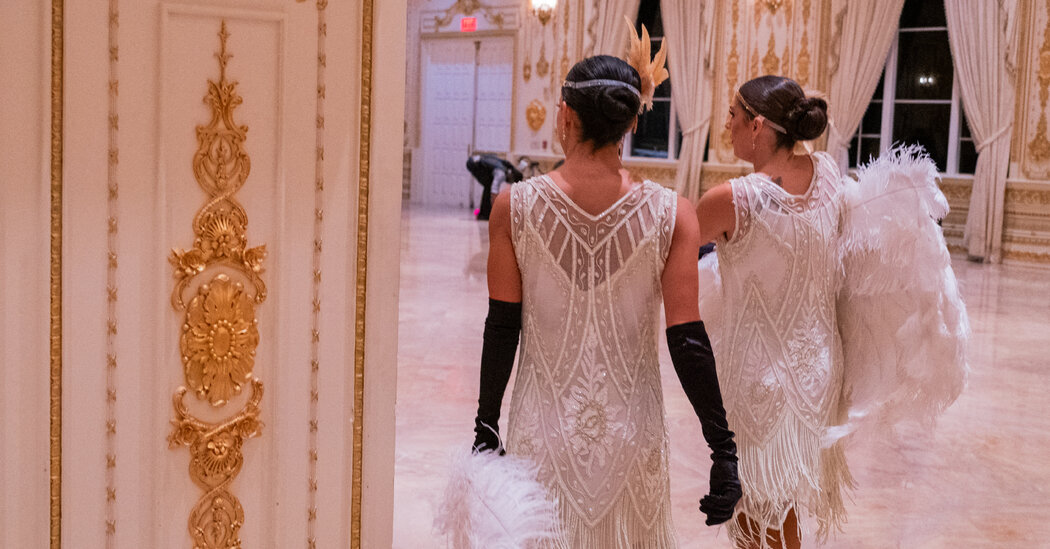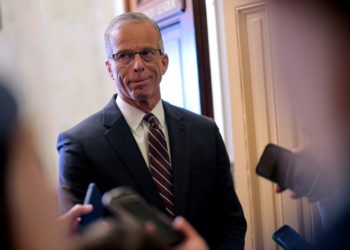This year marks the hundredth anniversary of the publication of F. Scott Fitzgerald’s “The Great Gatsby,” a book that you were probably required to read in high school but which makes much more sense when you go back and read it again as an adult. That’s especially true if you’ve been banged around enough by life to understand that the glamorous, elusive, self-invented party boy Jay Gatsby was not, in fact, someone you should aspire to be. He was not the hero. Also, it ended quite badly for him.
Donald Trump was clearly never much of a reader, so maybe it wasn’t that surprising — and it’s also just too perfect, of course — that on Oct. 31, with the federal government still shut down and SNAP benefits about to be disrupted, leaving about 42 million Americans without money they were counting on to eat, he was hosting a “Great Gatsby”-themed party at Mar-a-Lago.
It was one of those sticky images of Mr. Trump: the most powerful man in the world surrounded by a cavalcade of activity, the curve of a white feather poking out from a floral centerpiece, the blur of candles in candelabras and waiters in black vests affixed with royal-style crests. Next to the crests were bronze name tags that protruded awkwardly. Next to Mr. Trump was his multihyphenate secretary of state, Marco Rubio. In a photo, one could make out a smile and a bit of a laugh coming from Mr. Rubio’s mouth. Next to him was a woman in a 1920s-style headband who was looking out at the wide, lush expanse of Palm Beach.
The story of the rise and fall of the self-made semi-criminal Jay Gatsby takes place in the summer of 1922, during the presidency of Warren G. Harding, who is remembered for the Teapot Dome bribery scandal, although all manner of corrupt things went down during his term. The year before “Gatsby” was published, strict immigration quotas went into effect that drastically restricted the numbers of Southern Europeans and Jews allowed into the United States, as neither of those groups were at the time considered white by the Wasp establishment of the era, tipsy on their own Replacement Theory fears.
The 1920s were a time of extraordinary wealth creation and remarkably lax regulation. It’s hard imagining that Gatsby and those who partied at his house every night would have missed out on the kind of get-rich-quick schemes of the crypto and A.I. booms had they existed back then. It’s just as hard to imagine that our current Roaring ’20s is going to end any better than theirs ultimately did in October 1929.
In present-day America, there are signs of a stock market bubble. Food pantries are already strained. Inequality is rampant. The top 10 percent of U.S. households now make up nearly half of all spending, the highest level since the late 1980s. Many large companies aren’t hiring. More Americans are falling behind on their car payments. And health insurance rates are expected to increase for millions of Americans — a major reason that we have a government shutdown in the first place.
But the shutdown accurately reflects the administration’s priorities: the “big, beautiful bill,” which continues the tax cuts from Mr. Trump’s first administration and makes cuts to Medicaid. Americans aren’t happy about it. Four months after the signature policy bill was passed into law, according to polling, its approval rating is underwater by 12 points, and 83 percent of battleground voters know about it.
To say Americans are unhappy understates the moment, according to polling from ABC. Two-thirds of Americans say that the country is “pretty seriously off on the wrong track.” Mr. Trump successfully rode previous unhappiness to election twice on promises of “draining the swamp” and fixing a “rigged system,” and he often did a shtick on the campaign trail that he called the “weave” (nonsensical rambles) about the price of bacon. Mr. Trump has whipped up a populist frenzy but has had little interest in enacting populist legislation. Instead he hired the richest man in the world, a notably uncharitable billionaire, Elon Musk, to make the government more efficient, including by cutting grants to the National Institutes of Health for cancer research; firing a broad swath of federal employees, many of whom needed to be rehired; and, according to one estimate, costing taxpayers billions of dollars. But don’t worry, Trump has a backup supply of billionaires in his cabinet — the most of any administration ever.
Americans didn’t vote for Mr. Trump because they wanted him to demolish the East Wing and pave the Rose Garden, much less enrich his own family with crypto. They wanted him to unrig a system they felt was rigged against them.
But does Mr. Trump care? The most famous passage in “Gatsby” is probably the one in which the book’s narrator, Nick Carraway, describes the rich couple Tom and Daisy Buchanan as “careless people” — “they smashed up things and creatures and then retreated back into their money or their vast carelessness or whatever it was that kept them together, and let other people clean up the mess they had made.”
The president’s priority, as a “60 Minutes” interview with him that aired on Nov. 2 showed, is revenge. And of course getting unnamed companies to pay for that ballroom, a grift machine where people will come pay him even after it’s done for his favor.
It’ll be a good place to host future “Gatsby” parties, too.
Molly Jong-Fast is the host of the “Fast Politics” podcast and the author of “How to Lose Your Mother: A Daughter’s Memoir.”
The Times is committed to publishing a diversity of letters to the editor. We’d like to hear what you think about this or any of our articles. Here are some tips. And here’s our email: [email protected].
Follow the New York Times Opinion section on Facebook, Instagram, TikTok, Bluesky, WhatsApp and Threads.
The post Trump’s ‘Great Gatsby’ Party Did Not Accept SNAP appeared first on New York Times.




